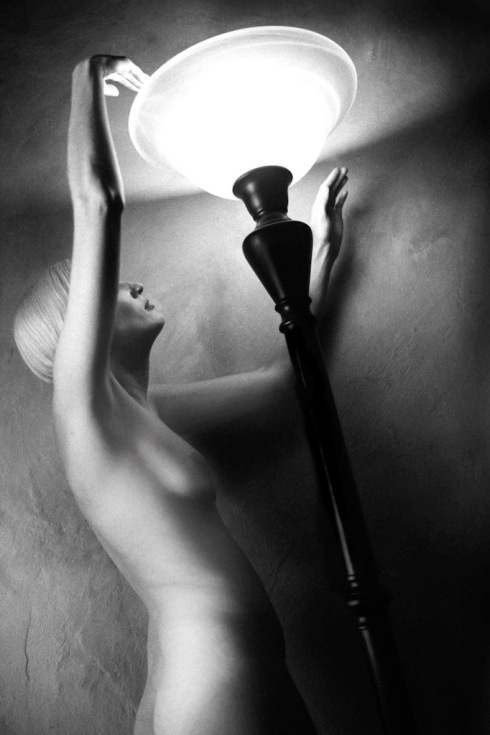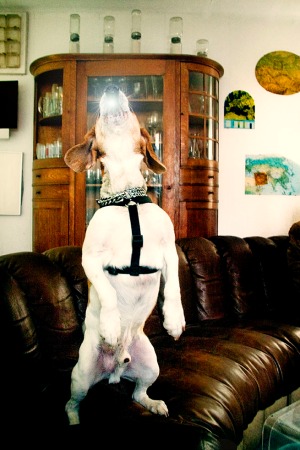 Pablos Holman illustrates the tricky aspects of RFID-technology.
Pablos Holman illustrates the tricky aspects of RFID-technology.
Let’s face it: usually, a hacker’s reputation isn’t the best – seen from the perspective of someone who isn’t really familiar with such topics. And so aren’t we. That’s why we will give you some basic impression of how brightly minded a brilliant hacker has got to be; and how he uses his brain capacities to do good on mankind’s problems.
Thanks to Berlin School of Creative Leadership we very much enjoyed the luxurious advantage of being taught by one of the best hackers: by Mr Pablos Holman himself.
For all those of us who still suffer from an uncertain vision about that what hackers real abilities are, Pablos Holman first explained to us, that hackers never accept a certain status quo and that they always try to look and go beyond any border. For that reason – like any other – even hackers use to enter airplanes and call ordinary passports their own. But what they can do with such an ordinary passport as well, is what it separates them from us, to so-called common people, who always obey rules in precisely that manner as they firstly appear.
 Pablos Holman indicates that «Samy is my hero».
Pablos Holman indicates that «Samy is my hero».
Alright, let’s start the fire: «Samy» is the guy who made it straight into «The Book of Internet History». It was him who created the legendary make-myspace-friends-script. Simply by visiting a profile both sides automatically became friends. Within weeks some myspace users gathered from 100k up to 1m of magic friends that came out of nowhere. However, out of a clearly structured hic et nunc «Samy» was not allowed to touch any computer for a period of ……. years/months?
By the way: What does such a verdict mean in reality? That you aren’t even allowed to use a cash dispenser in order to make an ordinary cash withdraw? That you aren’t even allowed to buy a train ticket from a ticket machine, which – of course – runs with a computer inside? May be it’s just meant to be a ritual, a procedure that separates the best from the good? May be it is designed as a special recruiting (Maßnahme) to get in touch with «The best, of the best of the best, sir!». Who knows…
Another important starter was that Pablos Holman showed us screenshots from TV-sets in hotel rooms, showing what the specific users was actually doing in their guessed but not existing privacy: making a money transfer of about $30m quit, for example. Certainly, all the bank details were on display as well.
 How to snap secret credit card details wirelessly?
How to snap secret credit card details wirelessly?
Pablos Holman demonstrates it.
«Can I have anyone’s credit card, please?» No wonder that all participants instantly forgot theirs at home… So he took his, certainly an expired one, and caught his secret card details with a blimp of an eye.
 How to snap secret credit card details wirelessly?
How to snap secret credit card details wirelessly?
Pablos Holman demonstrates it.
 How to snap secret credit card details wirelessly?
How to snap secret credit card details wirelessly?
Pablos Holman demonstrates it.
***
Comments disabled in order to save the world,
not to forget the whales, of course.
***
 Den Beerdigungsfeierlichkeiten wohnten vier Weihbischöfe sowie – höchstpersönlich und etwas versteckt – das Lamm Gottes bei. Von hier aus wird er weiterhin die politischen Geschehnisse aufmerksam verfolgen; und gegebenenfalls auch steuern.
Den Beerdigungsfeierlichkeiten wohnten vier Weihbischöfe sowie – höchstpersönlich und etwas versteckt – das Lamm Gottes bei. Von hier aus wird er weiterhin die politischen Geschehnisse aufmerksam verfolgen; und gegebenenfalls auch steuern. Click to enlarge mccarthiedly
Click to enlarge mccarthiedly «Seaside Rendez-Vous» by Andreas Baier
«Seaside Rendez-Vous» by Andreas Baier Larry Gagosian’s Experimental Interview
Larry Gagosian’s Experimental Interview Lucio Fontana at Tornabuoni
Lucio Fontana at Tornabuoni Photograph by Andreas Baier
Photograph by Andreas Baier «Supermoon» by Andreas Baier
«Supermoon» by Andreas Baier «Living Room Lion» by Andreas Baier
«Living Room Lion» by Andreas Baier Photograph by our staff-photographer Andreas Baier
Photograph by our staff-photographer Andreas Baier Photo by our staff-photographer Andreas Baier
Photo by our staff-photographer Andreas Baier All photographs by Andreas Baier
All photographs by Andreas Baier



















 All photographs by our staff photographer Andreas Baier
All photographs by our staff photographer Andreas Baier View out of the window at Fondation Beyeler
View out of the window at Fondation Beyeler Sam Keller, the director of Fondation Beyeler, introduces the audience right in the center of a quite bloody projection by the artist Douglas Gordon.
Sam Keller, the director of Fondation Beyeler, introduces the audience right in the center of a quite bloody projection by the artist Douglas Gordon. Douglas Gordon gets his mike right.
Douglas Gordon gets his mike right. Since Hans Ulrich Obrist still sticks in a traffic jam at the airport Douglas Gordon invites Sam Keller to share some absurd thoughts with the public.
Since Hans Ulrich Obrist still sticks in a traffic jam at the airport Douglas Gordon invites Sam Keller to share some absurd thoughts with the public.

 Douglas Gordon’s credo: «do so forever»
Douglas Gordon’s credo: «do so forever» Hans Ulrich Obrist arrives.
Hans Ulrich Obrist arrives. Our staff-photographer loves photographs from people standing right in the projection light of a beamer.
Our staff-photographer loves photographs from people standing right in the projection light of a beamer. Our staff-artist loves to create artistic portraits based on real photographs.
Our staff-artist loves to create artistic portraits based on real photographs.
 With the help of this little bottle friend Douglas Gordon convinces selected members of the audience to enter the stage.
With the help of this little bottle friend Douglas Gordon convinces selected members of the audience to enter the stage.




 A perfect performance by «The Mothers’ Whistlers».
A perfect performance by «The Mothers’ Whistlers». Also the sound of a popping bottle cork is part of the sound collage, which is caught by Douglas Gordon and Jonas Mekas.
Also the sound of a popping bottle cork is part of the sound collage, which is caught by Douglas Gordon and Jonas Mekas. Hans Ulrich Obrist is documenting the performance.
Hans Ulrich Obrist is documenting the performance. A group shot of all members of the audience …
A group shot of all members of the audience … … conducted by the artist Douglas Gordon.
… conducted by the artist Douglas Gordon.






 Real happiness has many faces.
Real happiness has many faces.
 The Fondation Beyeler also offers perfect conditions as a daylight studio for photography as well. Here: Sam Keller, director of Fondation Beyeler, and Jonas Mekas, the «godfather of American avant-garde cinema».
The Fondation Beyeler also offers perfect conditions as a daylight studio for photography as well. Here: Sam Keller, director of Fondation Beyeler, and Jonas Mekas, the «godfather of American avant-garde cinema». A made to measure paper blanket by the famous French artist
A made to measure paper blanket by the famous French artist



 Visitors on Art|2015|Basel
Visitors on Art|2015|Basel ODEON – Théâtre de l’Europe:
ODEON – Théâtre de l’Europe:




































































 Cover «Curriculum Vitae» with an essay by Klaus Honnef
Cover «Curriculum Vitae» with an essay by Klaus Honnef  flashlight painting (Blitzlichtgemälde) «Teatime»;
flashlight painting (Blitzlichtgemälde) «Teatime»;  flashlight painting (Blitzlichtgemälde) «Cube Base» –
flashlight painting (Blitzlichtgemälde) «Cube Base» –  Ralph Gibson: «LampNude»
Ralph Gibson: «LampNude» Jeff Dunas and Ralph Gibson
Jeff Dunas and Ralph Gibson 
You must be logged in to post a comment.